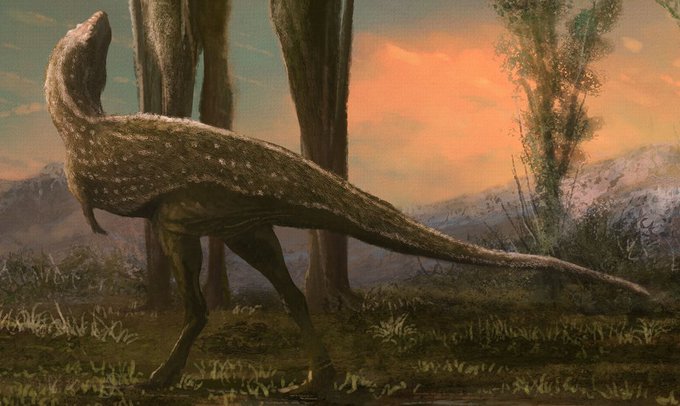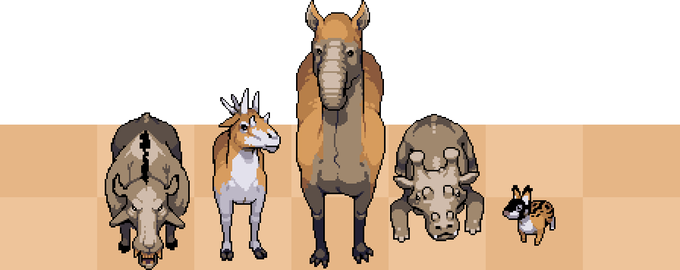MioceneのTwitterイラスト検索結果。 148 件中 7ページ目
The Shloom (Tachyglossus Tridactyla Afer) Is An Extinct Species Of Echidna, Giant Anteater And Aardvark. The Genus Was Endemic To Australia, Living From The Miocene Through To The Pleistocene Epochs.
Here's the Named in action, defending their herd from attack. #Ratha #graphicnovel . This is set in the Early Miocene, about 20 million years ago. Ratha and her kind descended from #nimravids.
The #Ratha #GraphicNovel is set in the early #California #Miocene, just after the #Oligocene. WIP by Dani Long and Tod Wills. We used this page to show various strange creatures of that time. Can you name them? #comic #paleofiction #xenofiction
#FossilFriday
Absence of very large penguins today is likely due to the Oligo-Miocene radiation of marine mammals.
Mayr et al. 2017 @NatureComms
A Paleocene #penguin from New Zealand substantiates multiple origins of #gigantism in fossil Sphenisciformes
https://t.co/lsypVXeUde
Pediomeryx yumaceras North America from the early Miocene epoch & died out 5 million years ago.
(Credit: WillemSvdMerwe)
3D surface of the talus of a platyrrhine primate from the early Miocene of Peru. https://t.co/zeSxrUh3ji
The bathornids were lesser-known relatives of the famous South American terror birds that inhabited North America from the Eocene to the Miocene. Here's the largest species, Paracrax gigantea.
@JoschuaKnuppe My bird noodle: Thalassospheniscus americanus. A species descended from Miocene banded penguins that resides in the deep and freezing waters of the Pacific Northwest.
Rhynchotherium was a bizarre looking elephant that lived in North America during the Miocene & Pliocene.
For #FossilFriday, here's a sneak peek at the #paleoart I'll be exhibiting at the free #PopPalaeo public evening event on Dec 18th. Register here if you want to turn up: https://t.co/dama3O0doV. Art shows juv Gastoris, juv Tyrannosaurus, a Miocene vulture, and Rebellatrix.
Synthetoceras or the 'horned horse' from the Miocene epoch. Only males had the strange horn on their nose.
(Credit: https://t.co/Ajt2VOyvbL)
Prolibytherium is an extinct artiodactyl ungulate from Early Miocene North Africa & Pakistan. Males had huge, leaf-shaped ossicones (horn-like projections) & the females' were more horn-like.
(Credit: WillemSvdMerwe)
A new tuskless walrus from the Miocene of Orange County, California, with comments on the diversity and taxonomy of odobenids https://t.co/aiIWvyCzr4
#FossilFriday The delightfully bizarre teeth of the Oligocene-Miocene hippo-like mammal, Desmostylus (Fresno Co., CA, @calacademy Geology collection)
Meiolania was one of the largest tortoises ever, reaching 2.5 metres in length. They lived during the Miocene & Holocene & the last relict populations survived on New Caledonia until 3,000 years ago!
Behold, the majestic Paraphysornis, aptly nicknamed "Terror Bird." See how it proudly surveys its surrounding, king of the Miocene plains.
Majestic indeed... not so much when they're young. 😂
@AnimalAlphabets #AnimalAlphabets #Paraphysornis #TerrorBird #extinct #watercolor
Check out those ossicones! 👀 Probilytherium is a prehistoric relative of giraffes and okapis from the Miocene. Its large, butterfly-shaped “antlers” are actually ossicones, made out of ossified cartilage instead of bone. #FactFriday
Gomphotherium is an extinct genus of proboscidean that lived during the early Miocene in North America.
Some of the animals you will fight that I made for @CavemenStories. Wanted to stay away from dinosaurs so I'm borrowing more from the Miocene times :)














































